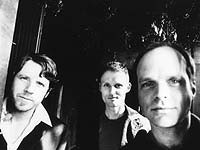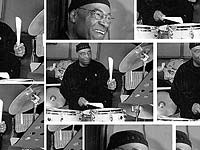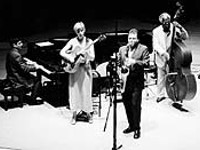Maria Schneider has to admit it; she was not quite the average child when it came to music.
It may have been normal to dance around the room when her mother put on a Duke Ellington or Artie Shaw record. But then there was that time when she was 7...
"My mom had this Enoch Light Orchestra album," says Schneider. "I remember listening to that and thinking I could do a lot better. I was always fascinated by orchestration."
Schneider has turned her childhood fascination into a career composing for and conducting jazz ensembles and orchestras all over North America and Europe.
When Schneider started piano lessons at the age of five, her teacher in the small town of Windom, Minnesota, taught her old-style jazz. By eight she was playing simple stride arrangements and receiving books of Cole Porter music for Christmas. But she had no idea that jazz was a living art form.
Her awakening came during her first year at the University of Minnesota, when she was playing an old Ellington record in her dorm room. A student stuck his head in and asked if she liked jazz. She was shocked that he even knew what it was. But he had a large record collection and promptly lent her some Coltrane and Herbie Hancock.
"I flipped out and went to a record store. I discovered Mingus and Bill Evans. Next to him in the bin was Gil Evans. I loved Bill Evans so I thought, let's check this guy out. Wow, he worked with Miles Davis! It was complete naïveté."
In retrospect, she believes this was not a bad discovery process.
"Today young people are taught about jazz before they come to it spiritually," she says. "It's a how-to approach to get a certain sound. How do you find your own naive expression if you've learned a way to do it and you haven't had a chance to play by intuition?"
Her fascination grew more intense in the early 1980s, when Toshiko Akiyoshi brought her band to Minneapolis. Schneider realized that it was possible to make a living writing for and leading a jazz ensemble.
By this time, Schneider had done so much naive grappling that she felt the need to study the fundamentals. She headed to Rochester and the Eastman School of Music for graduate study with two of the country's best teachers.
"It was incredible. Rayburn Wright had magnificent ears and was very supportive," she says. "Bill Dobbins was such a font of information. I learned so much just studying the songs of Monk, the way Monk would introduce a second idea in a song by hinting at it in the A section, things I would never have noticed on my own. He illuminated a lot of what was going on."
Schneider was just getting warmed up. She applied for and was awarded a National Endowment for the Arts grant to study with another top arranger, Bob Brookmeyer, in New York
"Bob encouraged me to ask why I was writing in a certain way," she says. "More often than not I was writing that way because it was always done that way. If you search inside for other possibilities, your music becomes more your own".
While Brookmeyer willingly expounded on exactly what he was doing, her next mentor was more elusive.
In 1985 she was introduced through a mutual friend to Gil Evans, the brilliant arranger who had collaborated with Miles Davis on Porgy and Bess, Sketches of Spain, and Miles Ahead. Schneider became his assistant, and began working with perhaps the most creative arranger in jazz.
Even after all of her training, the learning curve was steep.
"He had me doing re-orchestrations of his music for regular big band, and there was one passage that started with everybody on one note in unison and then the whole band slowly fanned out to a large, wide sonority that went very deep on the bottom and very high on the top," she says. "I orchestrated it in the way that I learned at Eastman. The trumpets go up in a spread voicing that's comfortable. The trombones go down in their range so it's comfortable and powerful.
"When he saw it he was just disgusted," she says. "He said 'No!' He completely flipped out. I thought, 'What could I possibly have done wrong?' I would get an A plus plus on this assignment. He said, 'No, I want some of the high instruments going to the bottom of the range so they can barely play down there. I want some of the low instruments going to the top so they're screaming.' So, at the end of this passage all of the horns would have this intense feeling of struggle. That's when I realized those things can't be taught."
The main lesson Schneider learned from Brookmeyer and Evans --- both of whom had distinctive styles --- was that she needed to develop her own approach.
For Schneider, that often means translating life experiences into music. She doesn't set out to write about experiences, but when she comes up with a texture or a melody, it sometimes evokes a memory, sensation, or feeling. Once the idea attaches itself to the music, she can develop the music around the idea.
"When that happens I lose my music-analytical mind and the music becomes about something more than music," Schneider says. "The reason I was attracted to music even as a child is, I would sit there and play and music would evoke something for me. When it would do that I would get completely lost and wrapped up in this other world. It was just an ecstatic experience. I'm always looking for that."
A few years ago she was playing around with some music that would congeal into one of her best-known compositions.
"I realized, 'Oh, my God, this reminds me of hang gliding. I can really move this into that area.' Then I had lots of energy to write that piece."
The associations can be powerful. Now, every time her band plays Hang Gliding, she feels the whole soaring experience over again from beginning to end.
Maria Schneider directs the Eastman Jazz Ensemble in a program of her compositions with guest soloist Rich Perry on Monday, June 9, in the Eastman Theatre, at 8 p.m. Dave Rivello and Brian Shaw open the show, leading the ensemble in works by four Down Beat award-winning Eastman graduate students.



